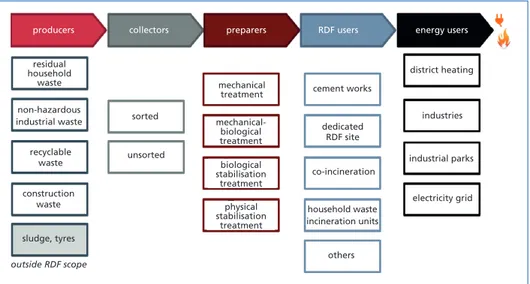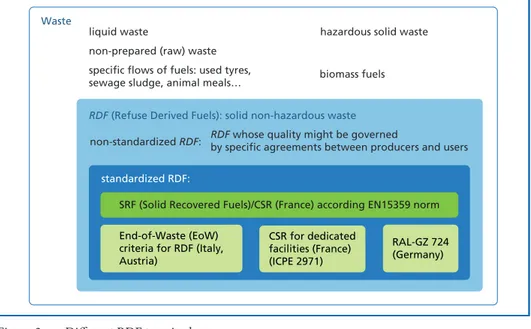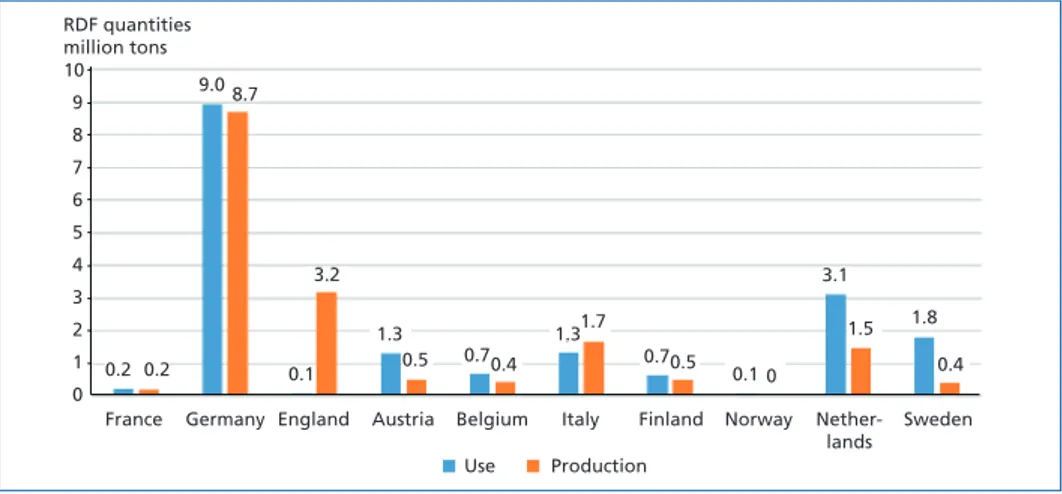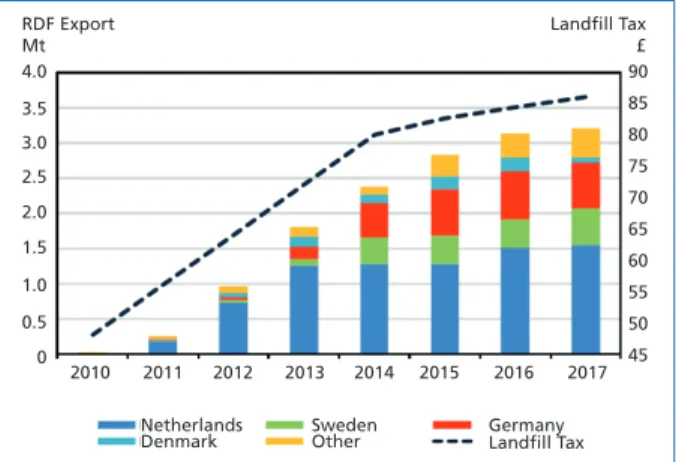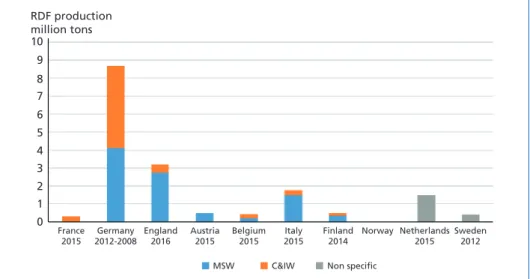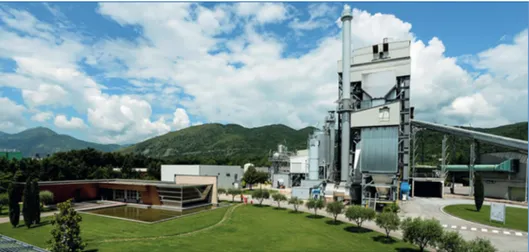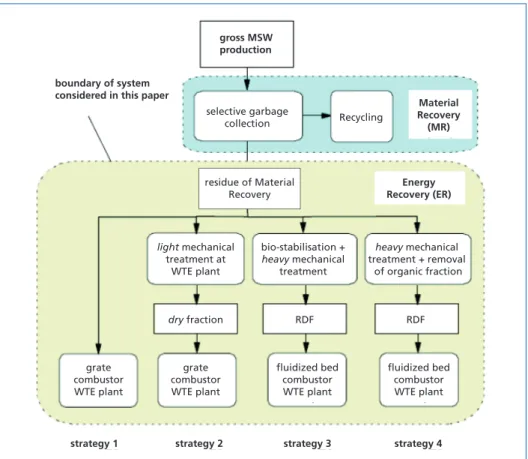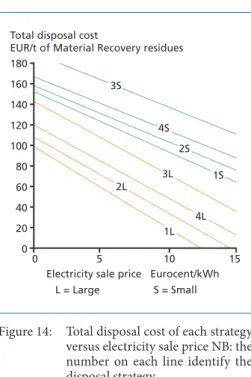CNIM - 35, rue de Bassano - 75008 Paris - France Tel.: +33 (0)1 44 31 11 00 - E-mail: contact@cnim.com www.cnim.com
Leeds (UK)
Energy-from-Waste plant 160.000t/a Image courtesy of Thomas Graham - Arup
09/2018 - Agence Huitième Jour
A RENEWABLE
SOURCE OF ENERGY Turnkey design & build and services
For:
Household waste
Commercial and industrial waste Biomass
Fuels derived from waste
To produce:
Recyclable materials Compost
Energy (heat and electricity)
MBT and SRF
Do We Need Pretreatment or Refuse Derived Fuel for Energy-from-Waste?
Christophe Cord’homme
1. Municipal solid waste characteristics ...450
1.1. MSW general characteristics ...450
1.2. MSW variability ...451
1.3. MSW thermal treatment ...451
2. Pretreatment objectives ...452
3. RDF value chain ...453
4. Terminology and standards ...454
5. RDF market situation in Europe ...456
5.1. RDF production and use quantities ...456
5.2. RDF import/export ...457
5.3. RDF production in Europe ...458
6. RDF produced quantity versus quality ...458
7. RDF use in Europe ...459
8. RDF impact on WtE costs ...461
8.1. Thermal treatment costs ...461
8.2. MSW pretreatment impact on costs ...462
9. Drivers behind the development of RDF ...464
10. Conclusion ...464
11. Literature ...465 Municipal Solid Waste is an important valuable source of low-carbon renewable en- ergy. Thermal treatment technologies are efficient to recover Energy from Municipal Solid Waste (MSW) and produce heat and power. Energy-from-Waste (EfW) plants contribute to the diversion of biodegradable municipal waste from landfill and secure a noteworthy reduction of greenhouse gas emissions.
MBT and SRF
The objective of this paper is to understand the variability in waste feedstock and the opportunities and interests for pre-processing them.
Throughout the world, Municipal Solid Waste is a fuel with some general common characteristics concerning physical, biological, chemical and thermal aspects. Its het- erogeneity in size and in composition and its high content in moisture and inert are among them.
Reliable and mature technologies have been developed in the last decades to deal with these specific topics and to guarantee a perfect combustion and energy recovery from this sustainable fuel.
By nature, Municipal Solid Waste is also presenting high physical and chemical feedstock variability, according to the location or the season for example. Cultural differences, climate, social and economic conditions have also an impact on MSW changing quality.
Nevertheless, one may observe a tendency to an increase of its variability. Selective col- lection and material recovery are modifying the compositions. Raw municipal wastes are now often replaced by residual wastes after sorting and/or preparation and they could be mixed with clinical wastes, sewage sludge or Commercial & Industrial wastes.
To integrate successfully this new feedstock, some questions are pending:
• What impacts on calorific values or chemical compositions could we note about MSW residual fraction?
• Are the existing technologies flexible enough to accept greater variability of the fuels?
• Are pre-processing required to obtain more homogeneous feedstock?
• What are the opportunities using feedstock production techniques for high calorific fuels with all various acronyms such as RDF (Refuse Derived Fuels), SRF (Solid Recovered Fuels), CDR, CSS, CSR or EBS ?
• What are the repercussions on thermal treatment technologies design, operation and costs?
• What are the effects on the global net energy recovery efficiency or the environmental impact?
• What are the overall benefits of improving the quality of the feedstock for the EfW plant?
The goal of this paper is to develop awareness to understand this fuel input variability and to evaluate the impacts and interests of waste pre-processing, such as waste pre-treatment or Refuse Derived Fuel use.
Is the game worth the candle?
1. Municipal solid waste characteristics 1.1. MSW general characteristics
Municipal Solid Waste (MSW) is generally a complex mixture of several materials different in physical and chemical characteristics as well as extremely variable in size.
MBT and SRF
MSW general characteristics are the following:
• Physical: heterogeneous and variable size,
• Biological: contains pathogens,
• Chemical: high moisture and high ash content, corrosive species and chemical pollutants,
• Thermal: mostly renewable combustible, with heating value similar to wood chips.
1.2. MSW variability
Due to cultural differences, climate, social & economic conditions, MSW changes in quality and quantity:
• on different time scales:
– daily with the example of the food market (packaging in the morning vs. spoiled fruits in the afternoon)
– seasonal (summer vs. Christmas)
– long term basis (decades) with new material appearing (plastics…) and some disappearing (coal ashes…),
• with different geographic locations:
– wet with high organic content in Asia
– low inert content in Japan because of burnable/non-burnable selection – very high calorific value in Switzerland
• with the mixture with other types of solid wastes such as : – Clinical waste
– Sewage sludge
– Commercial & Industrial
• Depending on the waste management process upstream such as:
– Selective collection and sorting impact (glass, packaging, bio-waste…) – Pretreatment with Mechanical Biological Treatment (MBT)
– Fuel preparation for Refuse Derived Fuel (RDF) or Solid Recovered Fuel (SRF) production.
1.3. MSW thermal treatment
Because of these general characteristics and variability, some efficient technologies have been developed to deal with Municipal Solid Waste thermal treatment and ener- gy recovery. In particular, the large and variable size of fuel elements affects the time required for their combustion. Therefore, the completion of combustion takes longer time for MSW than for other solid fuels.
MBT and SRF
The technological answers to these set of problems are the following in general:
• Physical: Grate combustion system, with specific fuel handling, strong mixing pro- cess and large combustion chamber size
• Biological: Complete combustion at high temperature during long residence time with high excess air for full oxidation
• Chemical:
– Large boiler design, with adapted steam conditions, material protection and ash handling for corrosion and clogging prevention
– Complete Flue gas treatment because of waste pollutants content
• Thermal: Smaller scale than fossil fuel power plant (in MW) with adapted thermal efficiency
To try to avoid or limit these constraints, some pretreatment or fuel preparation are foreseen.
2. Pretreatment objectives
In Europe, the energy transition and circular economy packages have the ambitions to disconnect the link between economic growth, raw materials consumption and waste disposal. Including ambitious objectives for renewable energy production, European directives and national laws require:
• drastic reduction of landfill disposal,
• minimum recycling rates for non-hazardous waste,
• extended producer responsibility (EPR) for specific waste flows management
• implementation of selective collection and sorting for some waste flows such as paper, plastic bottles, glass…,
• source separation for biowaste
• or even preparation and use of RDF
As indicated above, material or energy recovery from solid waste is facing some diffi- culties, linked to the presence of pollutants or unwanted substances which are going to reduce the material recovery rate or the efficiency of thermal treatment facilities (such as heavy metals or chlorine etc.), or cause health risks or greenhouse gas emissions.
The goal of pretreatments is to extract the compounds considered as polluting or non-recoverable, in order to transform the waste into a secondary raw material, to use in the industrial process of material and energy production.
In order to improve material or energy valorisation, the pre-treatment processes should have the targets to reduce the pollutants load, which is defined there as the elements which do not allow the valorisation, mainly in environmental terms.
MBT and SRF
This preparation stage may also consist in conditioning the waste by removing its non-recoverable part (or recoverable by other sectors), by increasing its dryness or removing elements, substances or organic compounds whose presence is forbidden by the technical specifications of secondary use.
Following the waste treatment hierarchy and considering material recovery as priority, this is meaning that high quality material recovery should avoid pollution of secondary materials by hazardous compounds.
This important topic has been emphasized by environmental organizations such as the European Environmental Bureau in their recent study Keeping it clean: How to protect the circular economy from hazardous substances. [6]
Depending on the waste management value chain, this is meaning that if this pollutants load should be avoided in some material or specific energy recovery process, it will have to be treated elsewhere in a good technical and economical manner. Depending on the end energy users, this is meaning that RDF should avoid any pollutants load (case with chlorine in cement plants) or could accept a concentration of these pollutants if RDF is corresponding to the residual part of high quality material recovery.
3. RDF value chain
Figure 1 is showing the full value chain of Refuse Derived Fuels. A good mix balance between these different flows should be considered to obtain a technical and economical optimization.
producers collectors preparers RDF users energy users
residual household
waste non-hazardous industrial waste
recyclable waste
construction waste
sludge, tyres
sorted
unsorted
mechanical treatment mechanical-
biological treatment biological stabilisation
treatment physical stabilisation
treatment
cement works
dedicated RDF site
co-incineration
household waste incineration units
others
district heating
industries
industrial parks
electricity grid
outside RDF scope
Figure 1: RDF value chain
Sources: Direction générale des entreprises (February 2019): Parangonnage européen du marché des combustibles solides de récupération. Retrieved from: https://www.entreprises.gouv.fr/files/files/directions_services/etudes-et-statistiques/Analyses/2019- 02-ANALYSECombustibleSolidesRecuperation.pdf.
Record: Utilisation des CSR et des RDF en Europe – synthèse bibliographique et situations administratives rencontrées sur le terrain (use of SRF and RDF in EUROPE), May 2018
MBT and SRF
Each flow or stakeholder has its own technical specifications and requirements de- pending on its process. Depending on energy users or national situation, RDF term does not have the same meaning. Let us try to clarify.
4. Terminology and standards
In order to avoid confusion, it is important to maintain the difference among a long list of abbreviations and acronyms:
• RDF/SRF are general abbreviations, used in Europe.
• CSR (Combustibles Solides de Récupération) refers to the fuel that corresponds to the French framework.
• CDR (Combustibili Derivati da Rifiuti) or CSS (Combustibili Solidi Secondari) in Italy.
• EBS (Ersatzbrennstoffe) or SBS (Sekundärbrennstoffe) in Germany.
• …
In general, RDF are solid non-hazardous waste prepared for energy recovery, derived from either municipal waste, commercial and industrial waste or from construction and demolition waste.
The term SRF has been chosen to refer to solid fuel, prepared from non-hazardous waste, and compliant with European standard EN 15359 or an equivalent national standard (or regulation).
European standard EN 15 359 defines a classification, specification and quality mana- gement system for standardized RDF as presented in Table 1. It does not define a quality threshold. The European standard is seldom used in practice.
Classification
characteristic Statistical measure Unit Classes
1 2 3 4 5
Net calorific value (NCV) Mean MJ/kg (ar) ≥ 25 ≥ 20 ≥ 15 ≥ 10 ≥ 3
Chlorine (Cl) Mean % (d) ≤ 0.2 ≤ 0.6 ≤ 1.0 ≤ 1.5 ≤ 3
Mercury (Hg) Median
80th percentile mg/MJ (ar) ≤ 0.02
≤ 0.04 ≤ 0.03
≤ 0.06 ≤ 0.08
≤ 0.16 ≤ 0.15
≤ 0.30 ≤ 0.50
≤ 1.00
Example of classification: SRF having a mean net caloric value of 19 MJ/kg (ar = as received), a mean chlorine content of 0,5 % (d = dry) and a median mercury content of 0.016 mg/MJ (ar) with a 80th percentile value of 0.05 mg/MJ (ar) is designated as: Class code NCV 3; Cl 2; Hg 2
Table 1: Classification system for SRF according to EU standard EN 15359
In France, the regulatory regime (Decree No. 2016-630) concerning the preparation of CSR and the quality control of CSR received by users is rather unique. It defines the CSR as an RDF that meets certain requirements with thresholds – Net Calorific Value (NCV), halogens, mercury content… –, requirements relating to quality control and an obligation to respect waste hierarchy.
MBT and SRF
With the exception of France, Italy and Austria have set up a regulatory definition of RDF, but these countries do not define the minimum quality to be achieved. These countries have also introduced the possibility of RDF End of Waste status, but none seems to be currently applied in practice for RDF.
Germany has also a national standard for RDF (RAL-GZ 724), mainly aimed at power plants, cement kilns and limekilns, but it is not used by facilities dedicated to energy recovery from RDF. In Germany, Austria and Sweden, RDF energy recovery plants are not constrained to recover only RDF; they can recover other non-hazardous waste if the technical conditions allow it. Figure 2 summarizes the situation.
Figure 2: Different RDF terminology
Sources: Direction générale des entreprises (February 2019): Parangonnage européen du marché des combustibles solides de récupération. Retrieved from: https://www.entreprises.gouv.fr/files/files/directions_services/etudes-et-statistiques/Analyses/2019- 02-ANALYSECombustibleSolidesRecuperation.pdf
In general, the quality of RDF is not covered by the regulations. Figure 3 is showing the repartition between standardized RDF and non-standardized RDF production (which is the majority) in different European countries.
In any case, the local authorities could apply extra requirements in the environmental permits. The quality of the RDF is often defined by agreements between producers and users according to technical criteria in order to respect emission limit values. The pa- rameters concern at minimum NCV, moisture content, density and ash content. Ferrous metal, Sulphur and chlorine content, granulometry and heavy metals concentration (especially mercury) could also be subject to threshold values.
Although RDF prepared from household waste is not a priority in the French projects, this category comprises the majority of the European RDF market. In other countries, the notion of RDF is used to refer to non-hazardous waste prepared by mechanical or mechan- ical biological sorting for energy recovery. Let us make a focus on RDF market in Europe.
End-of-Waste (EoW) criteria for RDF (Italy, Austria)
SRF (Solid Recovered Fuels)/CSR (France) according EN15359 norm
CSR for dedicated facilities (France) (ICPE 2971)
RAL-GZ 724 (Germany) Waste
liquid waste hazardous solid waste
non-prepared (raw) waste specific flows of fuels: used tyres,
sewage sludge, animal meals… biomass fuels
non-standardized RDF: RDF whose quality might be governed
by specific agreements between producers and users standardized RDF:
RDF (Refuse Derived Fuels): solid non-hazardous waste
MBT and SRF
Figure 3: Production of non-standardized RDF and standardized RDF
Sources: Direction générale des entreprises (February 2019): Parangonnage européen du marché des combustibles solides de récupération. Retrieved from: https://www.entreprises.gouv.fr/files/files/directions_services/etudes-et-statistiques/Analy- ses/2019-02-ANALYSECombustibleSolidesRecuperation.pdf.
Record: Utilisation des CSR et des RDF en Europe – synthèse bibliographique et situations administratives rencontrées sur le terrain (use of SRF and RDF in EUROPE), May 2018
5. RDF market situation in Europe 5.1. RDF production and use quantities
Around 18 to 20 millions of tons of RDF are produced and used in Europe per year.
The following graph shows the distribution and the comparison between production and use of RDF by country.
Figure 4: Comparison of RDF quantities produced and used per country
Sources: Direction générale des entreprises (February 2019): Parangonnage européen du marché des combustibles solides de récupération. Retrieved from: https://www.entreprises.gouv.fr/files/files/directions_services/etudes-et-statistiques/Analy- ses/2019-02-ANALYSECombustibleSolidesRecuperation.pdf.
Record: Utilisation des CSR et des RDF en Europe – synthèse bibliographique et situations administratives rencontrées sur le terrain (use of SRF and RDF in EUROPE), May 2018
The difference is made up by some import/export flows between the countries.
standardised RDF non-standardised RDF or characteristics unknown Production
million tons
0 1 2 3 4 5 6 7 8 9 10
France 2015
Germany 2012-2008
England 2016
Austria 2015
Belgium 2012
Italy 2015
Finland 2014
Norway Netherlands 2015
Sweden 2012
not available
RDF quantities million tons
0 1 2 3 4 5 6 7 8 9 10
France Germany England Austria Belgium Italy Finland Norway Nether- lands Sweden Use Production
0.2 0.2 9.0 8.7
0.1 3.2
1.3
0.5 0.70.4 1.31.7 0.70.5
0.1 0 3.1
1.5 1.8 0.4
MBT and SRF
5.2. RDF import/export
Gate fee differences in waste thermal treat- ment plants between European countries has caused the development of an import and export market for combustible waste.
The main import-export flows of RDF are shown in Figure 5. The main exporting countries are the United Kingdom, the Netherlands, Italy, Norway and Germany.
The main importers are the Netherlands, Germany and Sweden with the help of their available capacities and their need for energy.
Let us focus on the UK case with Figure 6 and 7.
Figure 5: Main RDF import and export flows
Sources: Direction générale des entreprises (February 2019):
Parangonnage européen du marché des combustibles solides de récupération. Retrieved from: https://www.entreprises.gouv.
fr/files/files/directions_services/etudes-et-statistiques/Analy- ses/2019-02-ANALYSECombustibleSolidesRecuperation.pdf.
Record: Utilisation des CSR et des RDF en Europe – synthèse bibliographique et situations administratives rencontrées sur le terrain (use of SRF and RDF in EUROPE), May 2018
Figure 7:
RDF export from the UK versus UK landfill tax evolution
Source: Tolvick : UK RDF Export Market
Figure 6: Photo of wrapped UK RDF delivery by boat to a WtE plant
Source: EA/DEFRA
The evolution of the situation of UK RDF export from the UK to the continent is firstly linked to the landfill tax increase in this country and to a certain imbalance
in the speed of construction of waste management infrastructure in their domestic market. Nevertheless, everyone could now observe a stabilization or even a slowdown in these export flows due to the BREXIT impact. It has reduced the value of the Pound Sterling against the Euro and the economic interest of this export.
France, Finland and Bel- gium remain relatively out of this RDF trade market.
2010 2011 2012 2013 2014 2015 2016 2017 0
0.5 1.0 1.5 2.0 2.5 3.0 3.5 4.0 RDF Export Mt
45 50 55 60 65 70 75 80 85 90
Germany Landfill Tax
Landfill Tax
£
Netherlands
Denmark Sweden
Other
MBT and SRF
5.3. RDF production in Europe
In general, the production of RDF is based on pretreatment process of MBT or just Mechanical Treatment (MT) types. This is mainly depending on the inlet flow nature and its organic content and on national laws and standards. Figure 8 shows the quan- tities of RDF produced by country with the distribution between the two main types of waste inlet: MSW or Commercial & Industrial Waste (C&IW).
Figure 8: RDF production source between MSW and C&I Waste
Source: Record: Utilisation des CSR et des RDF en Europe – synthèse bibliographique et situations administratives rencontrées sur le terrain (use of SRF and RDF in EUROPE), May 2018
The quality and the NCV of the RDF in Europe are depending on the type of waste used to prepare RDF (MSW, C&IW or rejects from separately collected waste) and on the pretreatment process type corresponding to the end user specifications. Never- theless, the NCV of RDF prepared from C&IW is generally higher and in a narrower variation range than from MSW inlet. The RDF NCV could vary from 8 to 20 MJ/kg for RDF prepared from MSW. The quantity of produced RDF is strongly depending on this level of NCV.
6. RDF produced quantity versus quality
The recovery rate of a certain defined RDF quality will depend on the input waste quality and the multiple stage RDF production process applied. In some cases, this may lead to a conflict of interest between quantity (amount of RDF produced out of a certain type of input waste) and quality required by customer or the environmental constraints.
In general, the higher NCV of RDF is required; the lower is the recovery rate of RDF.
As shown in Figure 9, the Pomberger study (2008) determined the relationship between the NCV (net calorific value) and the yield (recovery rate) when processing MSW or Commercial & Industrial Waste (CW) by a RDF processing plant.
0 1 2 3 4 5 6 7 8 9 10
RDF production million tons
France 2015 Germany
2012-2008 England
2016 Belgium
2015 Italy 2015 Finland
2014 Norway Sweden
2012 Netherlands
2015 Austria
2015
MSW C&IW Non specific
MBT and SRF Figure 9: Relationship between RDF NCV and RDF recovery rate of feedstock in preparation
process
Source: Pomberger, 2008. Cited in: Anttila, L.: Waste-to-energy scenarios in the China context. Master thesis at Lappeenranta university of technology, 2013. Retrieved from: http://lutpub.lut.fi/bitstream/handle/10024/91465/master%20thesis%20lauri%20 anttila.pdf?sequence=4&isAllowed=y
For instance, if the NCV of 22 MJ/kg is required for RDF for example for cement industry typical requirement, the recovery rate will be only about 7 % with MSW as original substance. This is meaning that 93 % residual waste is coming out this RDF preparation process and is requiring some other final sink. This cement RDF use might only help to solve a very small part of the waste management problem. This recovery rate increases up to 20 % with C&IW.
In conclusion, there is a conflict of interest between a high RDF recovery rate and high quality (high NCV) of the RDF produced. The suitable end use for the produced RDF must be designed based on the specific case.
7. RDF use in Europe
RDF can be used as a substitute for fossil fuel in co-incineration plants (coal-fired and brown coal-fired power plants, cement kilns, limekilns), in municipal Waste-to-En- ergy plants (WtE/MSW-Incineration – MSWI) or in dedicated RDF units for energy production.
Municipal Waste (MW)
Commercial Waste
(CW)
0 10 20 30 40
50 100
Net calorific value (LHV) MJ/kgOS Recovery rate
w%
m22,CW = 20 %
m22,MW = 7 %
theoretical distribution of NCV due to sorting analysis practical recovery in SRF-processing plant
OS: Original Substance
MBT and SRF
User facilities fall into two main categories: first in incineration, (the main purpose of which is waste management) and then in co-incineration, (whose main objective is the production of energy or material). Non-standardized RDF is mainly intended for dedicated facilities or WtE and standardized RDF for cement kilns and coal-fired plants.
In the Netherlands, the RDFs used are of low quality (extraction of the mixed waste recycling fraction and imports from the United Kingdom).
The majority of the facilities in operation in Europe function by combustion, with gasification only occupying a very minor role (a few percent of the facilities identified).
Figure 10:
Repartition of RDF use in Euro- pean countries
Sources: Direction générale des entre- prises (February 2019): Parangonnage européen du marché des combustibles solides de récupération. Retrieved from:
https://www.entreprises.gouv.fr/files/
files/directions_services/etudes-et-statis- tiques/Analyses/2019-02-ANALYSE- CombustibleSolidesRecuperation.pdf.
Record: Utilisation des CSR et des RDF en Europe – synthèse bibliographique et situations administratives rencontrées sur le terrain (use of SRF and RDF in EUROPE), May 2018
Figure 11: CDR (SRF) - to-Energy dedicated Termovalorizzatore Pozzilli, Italy
Credit photo: Hera 0
1 2 3 4 5 6 7 8 9 10
France
Germany Englan d
Austria Belgium Italy
Finland Norwa y
Netherland s
Sweden RDF
million tons
non-dedicated thermal power stations (coal, lignite) cement works and lime kilns
so-called dedicated installations (generally heat-oriented for industry or district heating)
MSWI (elec. and/or heat if heat generally for district heating)
MBT and SRF
Fluidized-bed furnaces and grate furnaces share the market, with fluidized beds mainly used when the facility does not only use RDF but also a mixture of homogeneous different flows of waste (biomass, sludge, bone meal, etc.) or high quality RDF with a high NCV and a good preparation.
Nevertheless, CNIM has also a major experience with high quality SRF with a grate combustion. The Pozzilli plat in Italy is running since 2008 with high quality CDR (RDF in Italy) which has a nominal NCV around 15 MJ/kg. The CNIM/MARTIN reverse acting grate technology (VARIO Grate) allows the combustion of this rich fuel without any water-cooling.
Test have been done with RDF NCV up to 19 MJ/kg with this robust technology without any problems. This is a cold grate by principle as explained in the paper [4].
12,000 kJ/kg 19,000 kJ/kg
15,000 kJ/kg
8. RDF impact on WtE costs 8.1. Thermal treatment costs
A major point to understand is that thermal treatment plant costs are mostly related to its thermal power in MWth rather than its mass capacity or tonnage in t/h.
Let us consider a WtE plant n°1, designed for a capacity of 10 tons of MSW per hour with a nominal NCV of 9 MJ/kg. It will have a thermal power input of 25 MWth. Let us now compare this facility with a WtE plant n°2 of an equivalent thermal power input of 25 MWth, but treating 7.5 t/h of RDF at 12 MJ/kg
In first approximation, as the thermal power input is equivalent, most of the parameters of these two plants are similar in particular:
• the total power production in MWe,
• the total flue gas flow in Nm3/h,
• the CAPEX
• and also most of the OPEX main topics
Figure 12:
RDF/SRF tested on reverse acting grate
MBT and SRF
The main exception is concerning the residues quantities such as bottom ashes, which are more related to the quantities rather than thermal power. Even Air Pollution Control costs could be very similar as the pollutants concentrations could increase in relation with NCV, as the total quantity is often remaining in the residual part after pretreatment compared to the original flow.
Therefore one should not hope to reduce drastically the different costs CAPEX and OPEX or increase energy revenues by treating 25 % less fuel (7.5 t RDF/h in our ex- ample instead of 10 t MSW/h) if the thermal power input does not change (25 MWth).
This a common misunderstanding.
8.2. MSW pretreatment impact on costs
One should not consider the thermal treatment part alone, but the waste management system with the whole sequence of processes. This was the goal of the research lead by Pr Consonni from Politecnico di Milano [2, 3]. This study aim was to understand if
Figure 13: Residual MSW strategies considered
Source: Consonni, S, Giugliano, M.; Grosso, M. P.: Alternative strategies for energy recovery from municipal solid waste Part A: Mass and energy balances. In: Waste management 25 2 (2005): 123-35. Consonni, S.; Giugliano, M.; Grosso, M.; Rigamonti, L. (2007): Energy and environmental balances of energy recovery from municipal solid waste with and without RDF production.
Retrieved from: http://www.leap.polimi.it/leap/images/Documenti/Documenti_Ecate/R2_1_2.pdf gross MSW
production
boundary of system considered in this paper
Material Recovery (MR)
strategy 1 strategy 2 strategy 3 strategy 4
Energy Recovery (ER) selective garbage
collection Recycling
residue of Material Recovery
light mechanical treatment at
WTE plant
bio-stabilisation + heavy mechanical
treatment
heavy mechanical treatment + removal
of organic fraction
dry fraction RDF RDF
grate combustor WTE plant
grate combustor WTE plant
fluidized bed combustor WTE plant
fluidized bed combustor WTE plant
MBT and SRF
the preparation of residual waste ahead of combustion in dedicated waste-to-energy plants could either increase efficiency or reduce environmental impact or reduce the cost of energy recovery.
This research assesses different strategies for energy recovery from MSW based on mass, energy, environmental and economic considerations.
The considered feedstock is the residual fraction after selective collection and material recovery (RMSW). The four alternative strategies shown in Figure 13 correspond to the options often considered by several municipalities to recover energy from MSW. In strategy 1, the RMSW is fed directly to a combustion furnace. In strategy 2, the RMSW is first pretreated by light mechanical treatment. Strategies 3 and 4 are including bio- logical treatment for the organic fraction (MBT); the RMSW is converted into RDF, which is then combusted in dedicated combustion system.
To examine the relevance of scale, they considered two sizes of waste management system (small/large).
As shown in Figure 14 and considering the whole sequences of these waste manage- ment strategies, it appears that:
• pre-treating the RMSW in order to increase the heating value of the feed- stock fed to the WtE plant has marginal effects on the energy efficiency of the WtE plant,
• the more important the pre-treatment, the smaller the amount of energy re- covered per unit of RMSW,
• pre-treatment of RMSW ahead of the WTE plant does not provide any envi- ronmental benefits as RDF production worsens almost all impact indicators,
• the cost of all strategies with pre-treat- ment is always higher. The benefits of improving the quality of the feedstock to the WTE plant do not compensate the cost of such improvement,
Figure 14: Total disposal cost of each strategy versus electricity sale price NB: the number on each line identify the disposal strategy
Source: Consonni, S.; Giugliano, M.; Grosso, M.; Rigamon- ti, L. (2007): Energy and environmental balances of energy recovery from municipal solid waste with and without RDF production. Retrieved from: http://www.leap.polimi.it/leap/
images/Documenti/Documenti_Ecate/R2_1_2.pdf
• scale-up impact between small and large systems is much more important than pretreatment strategies,
• total disposal cost is always very sensitive to the electricity sale price.
In conclusion, the most viable option according to this study is the one based on direct combustion of RMSW in a large-scale grate combustion plant (Strategy 1L). NB : the different figures in Figure 14 should be considered in relative values between the different scenario and not absolute regarding the price evolution.
0 20 40 60 80 100 120 140 160 180
Electricity sale price Eurocent/kWh Total disposal cost
EUR/t of Material Recovery residues
0 5 10 15
L = Large S = Small 2L
1L 4L 3L 3S
4S 2S
1S
MBT and SRF
The RDF production option might gain some interest when its energy content might be recovered with a significantly higher efficiency than what can be obtained in a tradi- tional WtE plant, as it could be the case for co-combustion in suitable coal-fired power plants or cement kilns. However, the RDF quality requirement on NCV and pollutants contents in these processes is limiting hugely the treated RDF quantity and therefore is leaving a majority of residues to deal with from this high quality RDF preparation.
9. Drivers behind the development of RDF
In most countries in Europe, facilities producing and those using RDF are not in general the result of a public policy whose goal was to develop a RDF sector. They emerged mainly in the last 2 decades through a combination of the following factors:
• climate of high and increasing fossil fuel prices, pushing energy consumers to look for alternatives;
• combustible waste available at a competitive price, resulting from the implemen- tation of public policy instruments aimed at reducing landfill in the form of bans and/or dissuasive taxation
• European system of CO2 quotas favouring alternative energy overall compared with the most carbon fossil fuels;
• for some countries, placing dedicated RDF facilities in the incineration category as renewable energy, thus exonerating RDF energy production from CO2 quotas.
• national energy investment or operational subsidies or regulatory conditions can apply to facilities using RDF and encourage the economic model.
10. Conclusion
This paper is presenting this MSW fuel input variability and trying to evaluate the impacts and interests of waste pre-processing, such as waste pre-treatment or Refuse Derived Fuel use with a benchmark in different European countries.
The cost of landfill, influenced by the existence of taxes and/or the existence of bans on sending certain types of waste to landfill (raw waste, combustible waste) explains the preparation of a RDF/SRF market. The high cost of landfill or the ban on landfilling raw waste encourages waste producers to reduce the amount they send to landfill. In most countries with high RDF use, the cost of sending non-hazardous waste to landfill exceeds 100 EUR/t and/or that there were landfill bans in force.
The energy end-consumer is usually the driver behind the construction of the RDF use site.
The European RDF market has developed thanks to a demand for competitive rene- wable energy (context of rising prices before crisis, CO2 quotas); and an offer in fuel prepared from waste, the consequence of national policies aimed at reducing landfill.
However, the economic model of the facilities is very sensitive to the price of waste and energy.
One should evaluate if the game is worth the candle in its local situation.
MBT and SRF
11. Literature
[1] Anttila, L.: Waste-to-energy scenarios in the China context. Master thesis at Lappeenranta uni- versity of technology, 2013. Retrieved from: http://lutpub.lut.fi/bitstream/handle/10024/91465/
master%20thesis%20lauri%20anttila.pdf?sequence=4&isAllowed=y
[2] Consonni, S; Giugliano, M.; Grosso, M. P.: Alternative strategies for energy recovery from mu- nicipal solid waste Part A: Mass and energy balances. In: Waste management 25 2 (2005): 123-35 [3] Consonni, S.; Giugliano, M.; Grosso, M.; Rigamonti, L. (2007): Energy and environmental
balances of energy recovery from municipal solid waste with and without RDF production.
Retrieved from: http://www.leap.polimi.it/leap/images/Documenti/Documenti_Ecate/R2_1_2.
[4] Cord‘homme, C.; Gartner, E.: Energy from Waste plants: technology developments on the com- bustion system (CDR treatment, enriched air combustion...). SARDINIA procedings, 2009.
[5] Direction générale des entreprises (February 2019): Parangonnage européen du marché des combustibles solides de récupération. Retrieved from: https://www.entreprises.gouv.fr/files/
files/directions_services/etudes-et-statistiques/Analyses/2019-02-ANALYSECombustible- SolidesRecuperation.pdf
[6] European Environmental Bureau: Keeping it clean, How to protect the Circular Economy from Hazardous Substances. European Environmental Bureau Report, February 2017. Retrieved from: https://eeb.org/publications/83/waste-and-recycling/1651/keeping-it-clean-how-to-pro- tect-the-circular-economy-from-hazardous-substances.pdf
[7] Lombardi, L.; Carnevale, E.; Corti, A.: A review of technologies and performances of thermal treatment systems for energy recovery from waste. In: Waste Management, Volume 37, 2015.
[8] Record: Prétraitements avant valorisations matière et énergie des déchets solides (Pretreatments prior to matter and energy recovery of solid waste) – August 2017
[9] Record: Utilisation des CSR et des RDF en Europe – synthèse bibliographique et situations administratives rencontrées sur le terrain (use of SRF and RDF in EUROPE), May 2018 [10] Tolvick: UK RDF Export Market
[11] World Bank: Technical guidance report Municipal Solid Waste Incineration – 1999
Contact Person
Christophe Cord’homme
CNIM Group (Constructions Industrielles de la Méditerranée) Business & Products Development Director
35, rue de BASSANO 75008 PARIS FRANCE
ccordhomme@cnim.com +33 1 44311129
Dorfstraße 51
D-16816 Nietwerder-Neuruppin
Phone +49.3391-45.45-0 • Fax +49.3391-45.45-10 E-Mail: order@vivis.de
TK Verlag GmbH
order now www. .de
Utilisation of Sewage Sludge
Due to recent alterations in the legal framework in Germany, the market for utilisation of sewage sludge will be fundamentally changing in the near future. On the one, hand the application in agriculture as fertilisier will be largely restricted. On the other hand, the political will to strengthen the circular economy will be provided.
Regarding the sewage sludge the focus lies on the recovery of phosphorous, which is due to the European Commission designated as a critical raw material since 2014.
Numerous procedural approaches considering the recovery of phosphorous from primary sludge or from the residues of thermal treatment exist but with different development status.
Against the background of a manifold industrial sector regarding the specification (dimension, stages of treatment steps) and the periphery (urban, rural, local options for utilization) of the sewage plants, many operators seek for meaningful technical solutions and economic concepts. The book will be released accompa- nied to the “Berliner Klärschlammkonferenz” (Berlin Sewage Sludge Conference) in November 2018 and will give a review to the altered legal framework as well as to innovative procedures and experiences in practice.
Published: November 5, 2018 ISBN: 978-3-944310-43-5 Hardcover: 574 Pages,
with coloured illustrations Price: 75.00 EUR
3
Karl J. Thomé-KozmienskyMineralische Nebenprodukte und Abfälle
4
Verwertung von Klärschlamm
KlärschlammStephanie Thiel | Elisabeth Thomé-Kozmiensky
Klärschlamm
Stephanie Thiel
Elisabeth Thomé-Kozmiensky
VERWERTUNGVON KLÄRSCHLAMMHolm | Thomé-Kozmiensky | Quicker | Kopp-Assenmacher
Olaf Holm Elisabeth Thomé-Kozmiensky Peter Quicker Stefan Kopp-Assenmacher
Bibliografische Information der Deutschen Nationalbibliothek Die Deutsche Nationalbibliothek verzeichnet diese Publikation in der Deutschen Nationalbibliografie; detaillierte bibliografische Daten sind im Internet über http://dnb.dnb.de abrufbar
Thiel, S.; Thomé-Kozmiensky, E.; Winter, F.; Juchelková, D. (Eds.):
Waste Management, Volume 9 – Waste-to-Energy –
ISBN 978-3-944310-48-0 Thomé-Kozmiensky Verlag GmbH
Copyright: Elisabeth Thomé-Kozmiensky, M.Sc., Dr.-Ing. Stephanie Thiel All rights reserved
Publisher: Thomé-Kozmiensky Verlag GmbH • Neuruppin 2019 Editorial office: Dr.-Ing. Stephanie Thiel, Elisabeth Thomé-Kozmiensky, M.Sc.
Layout: Claudia Naumann-Deppe, Janin Burbott-Seidel, Sarah Pietsch, Ginette Teske, Roland Richter, Cordula Müller, Gabi Spiegel Printing: Universal Medien GmbH, Munich
This work is protected by copyright. The rights founded by this, particularly those of translation, reprinting, lecturing, extraction of illustrations and tables, broadcasting, micro- filming or reproduction by other means and storing in a retrieval system, remain reserved, even for exploitation only of excerpts. Reproduction of this work or of part of this work, also in individual cases, is only permissible within the limits of the legal provisions of the copyright law of the Federal Republic of Germany from 9 September 1965 in the currently valid revision. There is a fundamental duty to pay for this. Infringements are subject to the penal provisions of the copyright law.
The repeating of commonly used names, trade names, goods descriptions etc. in this work does not permit, even without specific mention, the assumption that such names are to be considered free under the terms of the law concerning goods descriptions and trade mark protection and can thus be used by anyone.
Should reference be made in this work, directly or indirectly, to laws, regulations or guide- lines, e.g. DIN, VDI, VDE, VGB, or these are quoted from, then the publisher cannot ac- cept any guarantee for correctness, completeness or currency. It is recommended to refer to the complete regulations or guidelines in their currently valid versions if required for ones own work.
